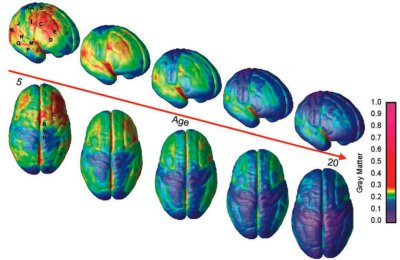Teen Brains, Under Construction
Spurts in brain development may help account for changes in teen behavior.
Share this:
- Share via email (Opens in new window) Email
- Click to share on Facebook (Opens in new window) Facebook
- Click to share on X (Opens in new window) X
- Click to share on Pinterest (Opens in new window) Pinterest
- Click to share on Reddit (Opens in new window) Reddit
- Share to Google Classroom (Opens in new window) Google Classroom
- Click to print (Opens in new window) Print
By Emily Sohn
Even though adults were once teenagers, they often treat teens like they’re from Mars. Many times, teens feel they’d fit in better on another planet.
The feelings are so widespread that bookstores are full of titles such as “Now I Know Why Tigers Eat Their Young: Surviving a New Generation of Teenagers” and “Help! My Family Is Driving Me Crazy: A Survival Guide for Teenagers.”
 |
|
Relationships matter a lot during the teen years, a time when teenage brains are changing rapidly. |
Surging hormones are often blamed for adolescent anxieties. More and more, however, scientists are realizing that important changes occur in the brain during the teen years.
Spurts in brain development, not sudden bouts of madness, they say, may help explain why kids start caring about different things, acting in new ways, and taking risks as they make the transition to adulthood.
“We don’t think [teenage brains are] damaged,” says neuroscientist Jay Giedd. He’s the chief of brain imaging at the National Institutes of Health (NIH) in Bethesda, Md. “They’re under construction.”
Brain scans
Every 2 years since 1991, a group of kids (and now adults) has been coming to Giedd’s lab. There, the participants have their brains scanned by magnetic resonance imaging (MRI) machines, which show details of brain structure. Study members also answer questions about their lives and mental health.
At first, Giedd looked only at the brains of healthy children to see if he could find evidence of physical brain changes in kids who later developed mental illnesses. Initial results, he says, were disappointing. Brains seemed to develop early and quickly.
 |
|
Kids are best at learning to play a musical instrument between ages 7 and 11. |
“By the first grade, the brain is already about 90 percent of its adult size,” Giedd says.
However, even though the size of the brain doesn’t change much, a closer look shows that the size of its parts does change a lot.
In 1996, Giedd’s team reported that the amount of gray matter (the type of brain tissue that processes information) increases until about age 11 in girls and 13 in boys. After that, gray matter decreases, while the amount of white matter goes up and up. White matter connects areas of gray matter and helps brain cells communicate with each other.
 |
|
MRI images reveal that, as teens get older, the amount of gray matter in the brain gets smaller as it’s replaced by white matter. |
| Paul Thompson, Kiralee Hayashi, and Arthur Toga/UCLA, N. Gogtay and Judith Rapoport/NIMH |
What these results mean, for one thing, is that girls’ brains tend to mature more quickly than boys’ brains do. The results also suggest that kids are best at learning how to play musical instruments or sports and developing other skills between ages 7 and 11. That’s when their gray matter is increasing the fastest. Once gray matter starts to go down, skills can be perfected, but it’s harder to learn new ones.
Learning machine
The brain’s frontal lobe seems to undergo a lot of development during the teen years. That’s the part of the brain that controls social activity, and that’s the time of life when kids start to care more about friends and what other people think of them.
“The bottom line is that the brain is very plastic,” Giedd says. “It changes much more than we used to think.”
 |
|
Team sports can play an important role in teen lives. |
Adolescence, in particular, appears to be a very busy time for that wrinkled lump behind your forehead. “During this time, there are so many changes, the potential to learn things is about as high as it will ever be,” Giedd says.
Among the most surprising things that Giedd and his coworkers have found is that brains don’t stop developing until people are in their mid-20s.
“Initially, we thought we’d study them until they were 16 or 18,” Giedd says. “Only recently, we thought, ‘Wow, we should follow them longer to find out when things stop maturing.'”
The scientists now have about 4,000 brain scans from 2,000 people. For some individuals, they have six or seven scans covering 15 years of development.
Taking risks
It took 10 years for the researchers to map the patterns and timing of brain development. Now, they’re trying to figure out how changes in the brain contribute to changes in behavior. They also want to know whether school, music, sports, diet, video games, parenting, TV-watching, medicine, or other factors influence those changes during adolescence.
One goal is to learn what teachers can do to take advantage of the time when their students’ brains change the most.
 |
|
Brains don’t stop developing significantly until people are in their 20s. |
If some parts of the brain develop sooner than others, for example, perhaps school subjects should be taught in a different order. “Maybe the parts of the brain doing geometry are different from the parts doing algebra,” Giedd says. “We haven’t had solid links like this, but that’s what we’re shooting for.”
Knowing what their brains are going through might also motivate teenagers to change their own priorities. “What you do with your brain during that time,” Giedd says, “could have a lot of good and bad implications for the rest of your life.”
Eventually, brain studies might help resolve conflicts at home. Teenagers are capable of learning a lot, but the parts of their brains related to emotions and decision-making are still in the works. As their brains undergo rewiring, teenagers are particularly vulnerable to risky behavior, such as drinking and driving too fast.
Brain development is no excuse for breaking curfew or taking big risks. Understanding what’s going on in there, however, can make the situation more manageable for everyone.
Going Deeper:







